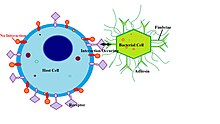Fimbria (bacteriology)
Fimbria (bacteriology)
Jump to navigation
Jump to search

Escherichia coli.
In bacteriology, a fimbria (Latin for 'fringe', plural fimbriae), also referred to as an "attachment pilus" by some scientists, is an appendage that can be found on many Gram-negative and some Gram-positive bacteria that is thinner and shorter than a flagellum. This appendage ranges from 3-10 nanometers in diameter and can be up to several micrometers long. Fimbriae are used by bacteria to adhere to one another and to adhere to animal cells and some inanimate objects. A bacterium can have as many as 1,000 fimbriae. Fimbriae are only visible with the use of an electron microscope. They may be straight or flexible.
Fimbriae carry adhesins which attach them to the substratum so that the bacteria can withstand shear forces and obtain nutrients. For example, E. coli uses them to attach to mannose receptors.
Some aerobic bacteria form a very thin layer at the surface of a broth culture. This layer, called a pellicle, consists of many aerobic bacteria that adhere to the surface by their fimbriae. Thus, fimbriae allow the aerobic bacteria to remain on the broth, from which they take nutrients, while they congregate near the air.
"Gram-negative bacteria assemble functional amyloid surface fibers called curli."[1] Curli are a type of fimbriae;[2] another type are called type I fimbriae.[2] Curli are composed of proteins called curlins.[1] Some of the genes involved are CsgA, CsgB, CsgC, CsgD, CsgE, CsgF, and CsgG.[1]

This figure depicts fimbriae adhesion. In this process the fimbriae of a bacterial cell adhere to specific proteins called receptors, found on the outer membrane of the host cell. They do this through a specific interaction between the receptors of the host cell and the perfectly matched adhesions found on the bacteria’s fimbriae. This process of adhering bacterial cells to a host cell, can lead to the colonization of that host cell as more and more bacterial cell collect around them, and is integral to the continued survival of the bacteria as it goes on to infect tissues and entire organs. [3]
Virulence[edit]
Fimbriae are one of the primary mechanisms of virulence for E. coli, Bordetella pertussis, Staphylococcus and Streptococcus bacteria. Their presence greatly enhances the bacteria's ability to attach to the host and cause disease.[4]
References[edit]
^ abc Epstein, EA; Reizian, MA; Chapman, MR (2009), "Spatial clustering of the curlin secretion lipoprotein requires curli fiber assembly.", J Bacteriol, 191 (2): 608–615, doi:10.1128/JB.01244-08, PMC 2620823, PMID 19011034..mw-parser-output cite.citationfont-style:inherit.mw-parser-output .citation qquotes:"""""""'""'".mw-parser-output .citation .cs1-lock-free abackground:url("//upload.wikimedia.org/wikipedia/commons/thumb/6/65/Lock-green.svg/9px-Lock-green.svg.png")no-repeat;background-position:right .1em center.mw-parser-output .citation .cs1-lock-limited a,.mw-parser-output .citation .cs1-lock-registration abackground:url("//upload.wikimedia.org/wikipedia/commons/thumb/d/d6/Lock-gray-alt-2.svg/9px-Lock-gray-alt-2.svg.png")no-repeat;background-position:right .1em center.mw-parser-output .citation .cs1-lock-subscription abackground:url("//upload.wikimedia.org/wikipedia/commons/thumb/a/aa/Lock-red-alt-2.svg/9px-Lock-red-alt-2.svg.png")no-repeat;background-position:right .1em center.mw-parser-output .cs1-subscription,.mw-parser-output .cs1-registrationcolor:#555.mw-parser-output .cs1-subscription span,.mw-parser-output .cs1-registration spanborder-bottom:1px dotted;cursor:help.mw-parser-output .cs1-ws-icon abackground:url("//upload.wikimedia.org/wikipedia/commons/thumb/4/4c/Wikisource-logo.svg/12px-Wikisource-logo.svg.png")no-repeat;background-position:right .1em center.mw-parser-output code.cs1-codecolor:inherit;background:inherit;border:inherit;padding:inherit.mw-parser-output .cs1-hidden-errordisplay:none;font-size:100%.mw-parser-output .cs1-visible-errorfont-size:100%.mw-parser-output .cs1-maintdisplay:none;color:#33aa33;margin-left:0.3em.mw-parser-output .cs1-subscription,.mw-parser-output .cs1-registration,.mw-parser-output .cs1-formatfont-size:95%.mw-parser-output .cs1-kern-left,.mw-parser-output .cs1-kern-wl-leftpadding-left:0.2em.mw-parser-output .cs1-kern-right,.mw-parser-output .cs1-kern-wl-rightpadding-right:0.2em
^ ab Cookson, AL; Cooley, WA; Woodward, MJ (2002), "The role of type 1 and curli fimbriae of Shiga toxin-producing Escherichia coli in adherence to abiotic surfaces", Int J Med Microbiol, 292 (3–4): 195–205, doi:10.1078/1438-4221-00203, PMID 12398210.
^ WI, Kenneth Todar, Madison,. "Colonization and Invasion by Bacterial Pathogens". www.textbookofbacteriology.net. Retrieved 2016-12-03.
^ Connell I, Agace W, Klemm P, Schembri M, Mărild S, Svanborg C (September 1996). "Type 1 fimbrial expression enhances Escherichia coli virulence for the urinary tract". Proc. Natl. Acad. Sci. U.S.A. 93 (18): 9827–32. doi:10.1073/pnas.93.18.9827. PMC 38514. PMID 8790416.
External links[edit]
Fimbriae+Proteins at the US National Library of Medicine Medical Subject Headings (MeSH)
This bacteria-related article is a stub. You can help Wikipedia by expanding it. |
Categories:
- Bacteriology
- Bacteria stubs
(window.RLQ=window.RLQ||).push(function()mw.config.set("wgPageParseReport":"limitreport":"cputime":"0.384","walltime":"0.475","ppvisitednodes":"value":1033,"limit":1000000,"ppgeneratednodes":"value":0,"limit":1500000,"postexpandincludesize":"value":143185,"limit":2097152,"templateargumentsize":"value":581,"limit":2097152,"expansiondepth":"value":9,"limit":40,"expensivefunctioncount":"value":2,"limit":500,"unstrip-depth":"value":1,"limit":20,"unstrip-size":"value":17754,"limit":5000000,"entityaccesscount":"value":2,"limit":400,"timingprofile":["100.00% 284.210 1 -total"," 58.68% 166.768 1 Template:Reflist"," 52.87% 150.258 14 Template:Navbox"," 45.43% 129.116 2 Template:Citation"," 16.47% 46.816 1 Template:Protist_structures"," 14.30% 40.642 1 Template:Bacteria"," 6.60% 18.747 1 Template:Bacteria-stub"," 5.20% 14.791 1 Template:Asbox"," 4.77% 13.567 1 Template:Cite_journal"," 4.53% 12.878 4 Template:Icon"],"scribunto":"limitreport-timeusage":"value":"0.147","limit":"10.000","limitreport-memusage":"value":3754261,"limit":52428800,"cachereport":"origin":"mw1253","timestamp":"20190304013214","ttl":2592000,"transientcontent":false););"@context":"https://schema.org","@type":"Article","name":"Fimbria (bacteriology)","url":"https://en.wikipedia.org/wiki/Fimbria_(bacteriology)","sameAs":"http://www.wikidata.org/entity/Q1810775","mainEntity":"http://www.wikidata.org/entity/Q1810775","author":"@type":"Organization","name":"Contributors to Wikimedia projects","publisher":"@type":"Organization","name":"Wikimedia Foundation, Inc.","logo":"@type":"ImageObject","url":"https://www.wikimedia.org/static/images/wmf-hor-googpub.png","datePublished":"2007-02-25T04:12:20Z","dateModified":"2018-08-03T20:02:14Z","image":"https://upload.wikimedia.org/wikipedia/commons/d/d4/E._coli_fimbriae.png"(window.RLQ=window.RLQ||).push(function()mw.config.set("wgBackendResponseTime":631,"wgHostname":"mw1253"););

